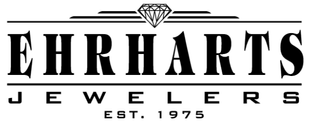Locally Owned In Denton, Texas
What to Look for When Buying Diamonds
Helpful Facts
Ehrhart's Jewelers wants to help you find the right diamonds. There are four major factors (the four C's) you need to know when selecting a diamond: cut, color, clarity, and carat. With this knowledge, you can be sure you're getting the best diamond at the best price. Call us for a free consultation at 940-382-5454
The Four C's of Diamonds
The Ideal Cut:
This Diamond cut describes a round brilliant diamond that has been cut to exact and mathematically proven proportions. Its symmetry, with 58 exactly placed facets, produces luster and beauty.
When a diamond is cut to the
ideal proportions, all of the light entering from any direction is totally reflected through the top and is dispersed into a sparkling array of colors.
Light entering the diamond reflects internally from facet to facet and is reflected back
through the top ONLY, creating maximum brilliance.
The Inferior Cut:
Most diamonds are spread in their cutting to retain maximum weight from the original rough. A heavier diamond will result, but at a dramatic sacrifice of potential fire and brilliance.
When a diamond is cut
too deep, light leaks out of the bottom. Brilliance is lost, and the center of the diamond will appear to be dark.
When a diamond is cut
too shallow, light leaks out of the bottom. Brilliance is lost, and the diamond appears watery, glassy, and dark.
The Four C's of Diamonds
The Ideal Cut:
This Diamond cut describes a round brilliant diamond that has been cut to exact and mathematically proven proportions. Its symmetry, with 58 exactly placed facets, produces luster and beauty.
When a diamond is cut to the
ideal proportions, all of the light entering from any direction is totally reflected through the top and is dispersed into a sparkling array of colors.
Light entering the diamond reflects internally from facet to facet and is reflected back
through the top ONLY, creating maximum brilliance.
The Inferior Cut:
Most diamonds are spread in their cutting to retain maximum weight from the original rough. A heavier diamond will result, but at a dramatic sacrifice of potential fire and brilliance.
When a diamond is cut
too deep, light leaks out of the bottom. Brilliance is lost, and the center of the diamond will appear to be dark.
When a diamond is cut
too shallow, light leaks out of the bottom. Brilliance is lost, and the diamond appears watery, glassy, and dark.
Color: Most diamonds, although appearing colorless, actually have slight tones of yellow and brown. As these tones become more easily apparent, the rarity and cost decrease. Ideal cutting dramatizes the sparkle of a diamond because it produces increased brilliance.
Clarity: Most diamonds contain naturally occurring internal characteristics called inclusions. The size, nature, location, and amount of inclusions determine a diamond's clarity grade and affect its cost.
Carat Weight: The weight of a diamond is measured in carats. One carat is divided into 100 parts called points. 1 ct. = 1.00; ct. = 0.50. The value of two diamonds of the same weight can vary GREATLY depending on the color, clarity, and especially the cut.
Color: Most diamonds, although appearing colorless, actually have slight tones of yellow and brown. As these tones become more easily apparent, the rarity and cost decrease. Ideal cutting dramatizes the sparkle of a diamond because it produces increased brilliance.
Clarity: Most diamonds contain naturally occurring internal characteristics called inclusions. The size, nature, location, and amount of inclusions determine a diamond's clarity grade and affect its cost.
Carat Weight: The weight of a diamond is measured in carats. One carat is divided into 100 parts called points. 1 ct. = 1.00; ct. = 0.50. The value of two diamonds of the same weight can vary GREATLY depending on the color, clarity, and especially the cut.
Contact Us
Our Hours
- Sun - Mon
- Closed
- Tue - Fri
- -
- Saturday
- -





